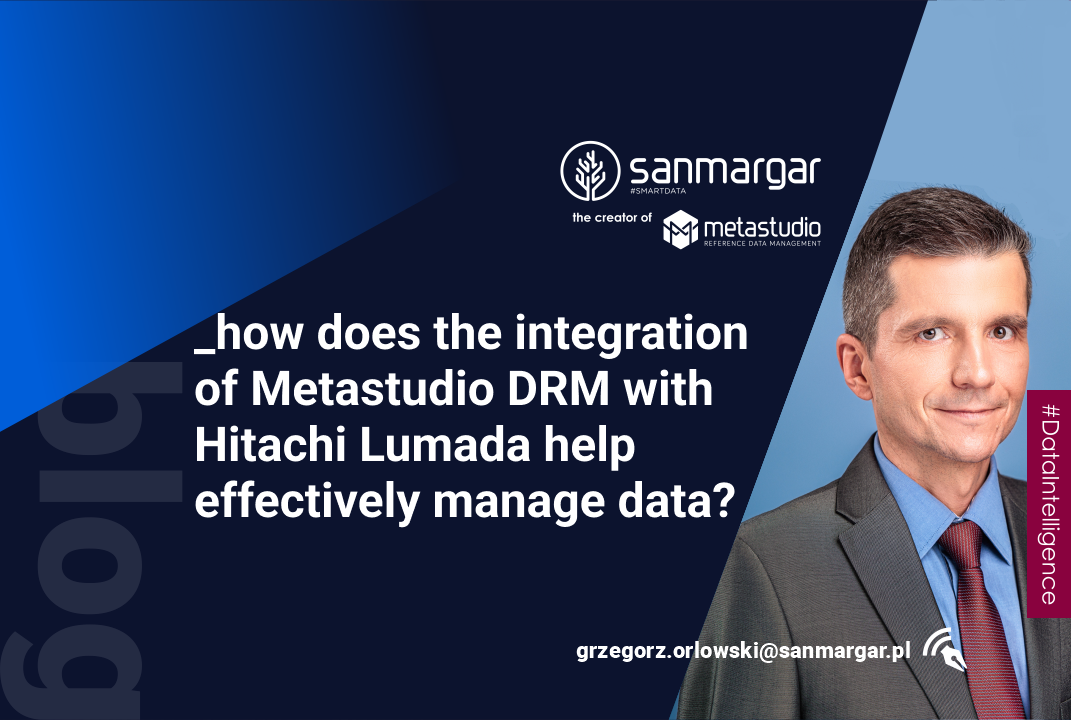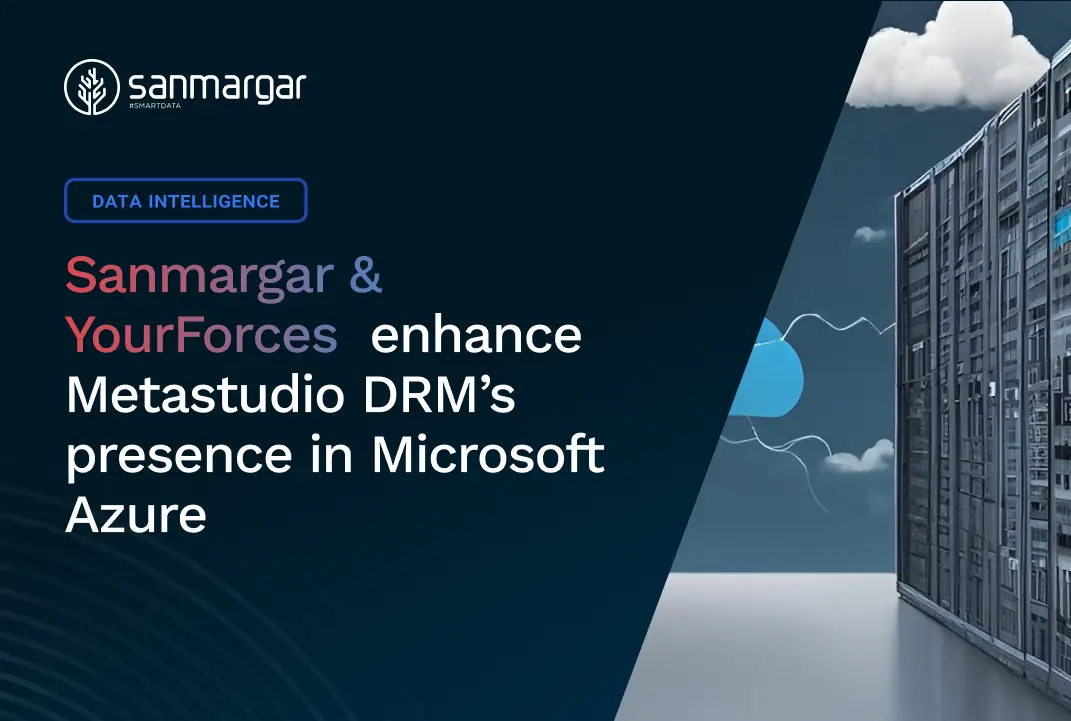The Lumada software, created by Hitachi, is an innovative solution for data management. It serves to integrate, harmonize, and analyze data from various sources, enabling companies to fully utilize their informational resources. Lumada’s application facilitates digital transformation, optimization of business processes, and decision-making based on reliable and current data. Together, Metastudio DRM and Hitachi Lumada can make data management in your organization significantly more efficient. What does the practical cooperation of these two tools look like? In the article below, I will present several perspectives on the potential synergy of Metastudio DRM and Hitachi Lumada.
Benefits of Integrating Metastudio DRM with Hitachi Lumada
Metastudio DRM serves as a central platform for managing and maintaining reference dictionaries, while Lumada, a product of Hitachi, can be configured to connect to Metastudio DRM as a data source. This allows Lumada to access the dictionary values stored in Metastudio DRM. Let’s analyze the key benefits resulting from the integration of these two powerful data management tools:
Seamless access to reference dictionaries: The integration of Metastudio DRM with Lumada allows direct access to reference dictionaries stored in Metastudio DRM, enabling their use in specific Lumada business processes. In this way, Lumada users gain convenient and direct access to key information and values contained in reference dictionaries.
Real-time updates: Thanks to the integration, any changes in the Metastudio DRM reference dictionaries, such as adding new values, updating existing records, or deleting outdated entries, are immediately reflected in Lumada. This ensures users have access to the freshest and most current data, crucial for making effective business decisions.
Consistent data model: Maintaining a uniform data model across the entire organization is possible thanks to the integration of Metastudio DRM with Lumada. Reference dictionaries stored in Metastudio DRM constitute a central source of information that can be used by various systems and applications, including Lumada. This eliminates data duplication, ensures information consistency, and facilitates data management.
Improved data quality and precision: Integration with Metastudio DRM allows Lumada to use precise and verified data from reference dictionaries. This translates into higher accuracy and quality of processed data, which is key for decision making, reporting, and analysis.
Simplified data management: Data management becomes easier thanks to the integration of Metastudio DRM with Lumada. Changes in reference dictionaries can be made centrally in Metastudio DRM, and then automatically propagated to Lumada. This eliminates the need for manual updating and maintenance of data, accelerating processes and minimizing the risk of errors.
In summary, the integration of Metastudio DRM with Lumada brings a range of benefits, including easy access to reference dictionaries, real-time updates, a unified data model, improved data quality and accuracy, and simplified data management. These advantages enable an organization to fully utilize the potential of data, streamline business processes, and make more accurate decisions.
Data Synchronization Between Metastudio DRM and Lumada
Metastudio DRM is capable of regularly synchronizing and updating reference dictionaries, delivering the freshest data. Lumada, on Hitachi’s side, can in turn establish a cyclical or event-based process for retrieving updated dictionary values from Metastudio DRM. This ensures that Lumada always uses the most current and accurate information. Let’s consider the business benefits of this synchronization:
Data consistency: Synchronization between Lumada and Metastudio DRM ensures continuous information consistency. This means that Lumada constantly uses the latest data and values stored in Metastudio DRM, eliminating the risk of working with outdated, inaccurate, or inconsistent information. Data consistency is crucial for effective business decision-making, data analysis, and error avoidance.
Updating reference dictionaries: Data synchronization allows for regular updates of reference dictionaries stored in Metastudio DRM, which are then transferred to Lumada. In case the organization introduces changes to the dictionaries, data synchronization ensures that Lumada uses the latest versions of these dictionaries. This guarantees higher quality and accuracy of processed data, eliminating the need for manual updating of these dictionaries in Lumada.
Simplified data management: Data synchronization between Lumada and Metastudio DRM simplifies data management across the entire organization. Changes in reference dictionaries can be centrally managed in Metastudio DRM, and then propagated to Lumada through the synchronization process. This offers a uniform, centralized, and consolidated data management, which is extremely important for large organizations or systems using the same dictionaries.
Flexibility and scalability: Data synchronization between Lumada and Metastudio DRM ensures the flexibility and scalability of these systems. As the organization evolves, adding new business processes or implementing new Lumada modules, data synchronization allows for updates and changes in reference dictionaries that are automatically propagated to all Lumada applications. This enables quick adaptation to changing business needs and scaling of Lumada-based solutions.
In summary, data synchronization between Lumada and Metastudio DRM brings benefits in the form of data consistency, updating of reference dictionaries, simplified data management, and flexibility and scalability. These elements form a solid foundation for precise analysis, accurate business decision-making, and effective use of data in the organization.
Using Reference Dictionaries to Define Business Rules in Lumada
Lumada can use dictionary values from Metastudio DRM to create precise business rules. By referring to appropriate dictionaries, Lumada can apply these rules to incoming data streams, enabling data validation, transformations, or routing based on values retrieved from Metastudio DRM.
Lumada can use dictionary values from Metastudio DRM to precisely determine which channel, process, or component should receive the data, depending on their features or properties. For example, when Lumada receives data related to financial transactions, it can refer to a reference dictionary from Metastudio DRM to check the type of transaction (e.g., “transfer”, “card payment”). Based on this, the data is routed to the appropriate processes or systems handling those types of transactions.
In this way, Lumada can dynamically and automatically steer data processing based on values retrieved from Metastudio DRM. This allows for flexible and automated data flows depending on their characteristics and defined business rules.
Enriching Data in Real-Time with Lumada and Metastudio DRM
Lumada uses reference dictionaries from Metastudio DRM to enrich data in real-time. As data flows through Lumada, dictionary values are used to enrich it, enabling more precise analysis, decision making, or personalized actions.
The process of enriching data in real-time involves adding or supplementing information in the incoming data as it is processed by Lumada, using Metastudio DRM. How does this work in practice?
Data stream: Lumada receives input data, for example, financial transactions or customer information.
Retrieving values from dictionaries: Lumada refers to reference dictionaries from Metastudio DRM and, based on certain features or data attributes, identifies appropriate dictionary values.
Enriching data: Lumada uses these values to enrich the data. For example, if the data contains a country code, Lumada can use the value associated with this code, such as the country’s name or time zone, and add these pieces of information as additional fields to the data.
Data update: After enriching the data, Lumada extends the original data with new information. These updated data are then used in further business processes, analyses, or real-time visualizations.
Use case example: Lumada receives a data stream related to credit transactions. Each transaction includes an identifier of the originating country. Using this identifier, Lumada retrieves the country’s name from Metastudio DRM and adds it as a new field to the transaction data. As a result, the analysis or reporting can include information about the country of origin of the transaction, increasing the value and usefulness of the data in business processes.
Bidirectional Communication Between Lumada and Metastudio DRM
Lumada, Hitachi’s innovative data management tool, can communicate bidirectionally with Metastudio DRM, providing it with feedback and updates. In situations where dictionary values require change, Lumada can facilitate this process by sending relevant data to Metastudio DRM. This ensures that dictionaries remain up-to-date and are adapted to evolving business requirements.
How does it work? Let’s assume that Metastudio DRM has a reference dictionary with a list of countries and their codes, which is used by Lumada for data analysis or transaction handling.
Dictionary modification: The organization decides to add new country codes or change existing ones. This need may arise from considering new markets or updating country codes.
Communication with Lumada: Metastudio DRM informs Lumada about the changes. The Metastudio DRM administrator adds or updates values in the dictionary and then informs Lumada about it.
Lumada Synchronization: Upon receiving the notification, Lumada initiates a synchronization process that updates its internal data source with the values retrieved from Metastudio DRM.
Use of new data: After the synchronization is complete, Lumada has access to the latest country values from Metastudio DRM. These updated values are then used in business processes.
The bidirectional communication between Lumada and Metastudio DRM enables data consistency maintenance, updating of reference dictionaries, and the use of the latest information available in Metastudio DRM. This allows Lumada to provide flexible data management and account for changes in reference dictionaries in business processes.
Conclusion
I hope this article, by showcasing a range of exemplary interactions between Metastudio DRM and Hitachi Lumada, has helped to understand how this synergy can enhance data management. Using Metastudio DRM and Lumada together contributes to increasing data consistency across systems, which in turn improves analysis capabilities and decision-making. Ultimately, this allows for effective information management in a business environment.




